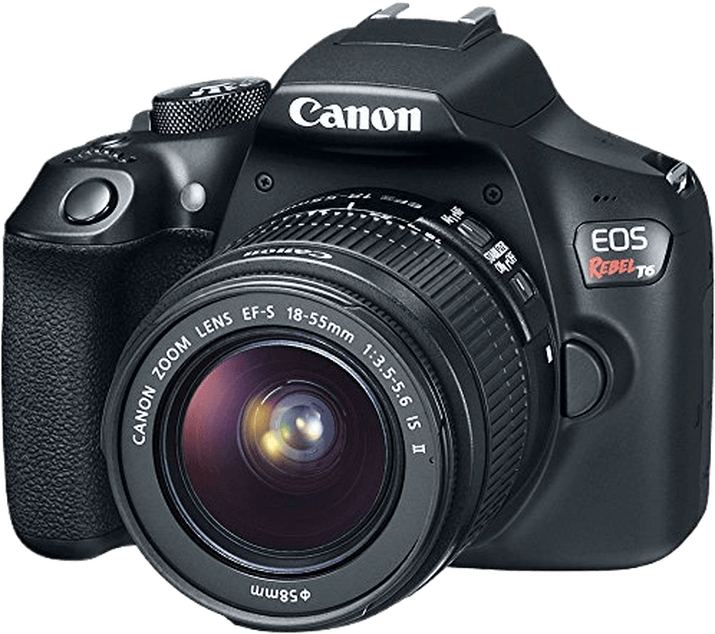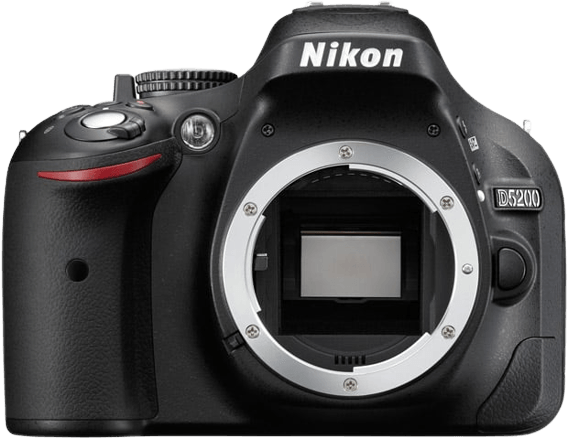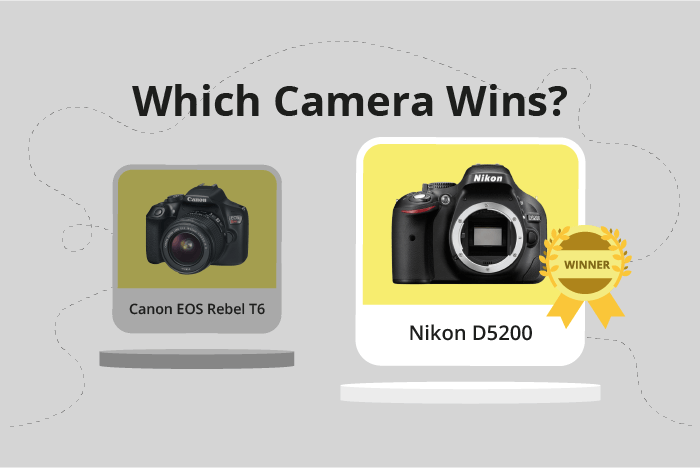Canon EOS Rebel T6 / 1300D vs Nikon D5200 Comparison
Canon EOS Rebel T6 / 1300D

Nikon D5200

The Nikon D5200 outperforms the Canon EOS Rebel T6 / 1300D with a score of 56/100 compared to 39/100. Both cameras are DSLR models released in 2012 and 2016, respectively, and share similar dimensions, with the Nikon D5200 slightly heavier at 555g compared to the Canon’s 485g.
The Nikon D5200’s higher score is due to its better overall performance and features. However, the Canon EOS Rebel T6 / 1300D has its advantages, such as a lower launch price of $550 compared to the Nikon’s $897, making it a more budget-friendly option.
Taking all factors into consideration, the Nikon D5200 is the superior camera, but the Canon EOS Rebel T6 / 1300D offers a more affordable alternative for those seeking a DSLR camera on a budget.
Canon EOS Rebel T6 / 1300D vs Nikon D5200 Overview and Optics
The Nikon D5200 emerges as the winner in the optics comparison with a score of 65/100, while the Canon EOS Rebel T6 / 1300D scores 40/100. Both cameras share some common specifications, such as the CMOS sensor type, APS-C sensor size, and the absence of image stabilization. However, the Nikon D5200 outshines the Canon T6 in several aspects, making it the superior choice in terms of optics.
The Nikon D5200 boasts 24.1 megapixels, providing higher resolution images than the Canon T6’s 18 megapixels. This difference allows for more detail and better image quality in the Nikon D5200’s photos. Additionally, the Nikon D5200 has a faster shooting speed of 5 frames per second (fps) compared to the Canon T6’s 3 fps, which is advantageous for capturing fast-moving subjects or action shots.
Furthermore, the Nikon D5200’s Expeed 3 processor and a DXOMARK sensor score of 84 contribute to better overall performance and image quality than the Canon T6’s Digic 4+ processor and DXOMARK sensor score of 66. This translates to improved low-light performance, dynamic range, and color depth in the Nikon D5200.
On the other hand, the Canon T6 has the advantage of compatibility with the Canon EF-S lens mount, which offers a wide range of lens options. However, this advantage is somewhat negated by the Nikon D5200’s compatibility with the Nikon F DX lens mount, which also provides an extensive selection of lenses.
Taking all factors into account, the Nikon D5200 is the superior camera in terms of optics, offering better image quality, faster shooting speed, and enhanced performance. The Canon T6 falls short in comparison but still provides a decent option for beginners or casual photographers.
Canon EOS Rebel T6 / 1300D vs Nikon D5200 Video Performance
The Nikon D5200 outperforms the Canon EOS Rebel T6 / 1300D in video capabilities, with a video score of 70/100 compared to the Canon’s 43/100. Both cameras share some common specifications, including Full HD video resolution and maximum video dimensions of 1920 x 1080 pixels.
The Nikon D5200’s superiority in video capabilities is evident in its higher maximum video frame rate of 60fps, while the Canon T6 / 1300D offers only 30fps. This higher frame rate allows the Nikon D5200 to capture smoother and more detailed video, especially when recording fast-moving subjects or scenes. Moreover, the Nikon D5200 includes built-in time-lapse functionality, enabling users to create stunning time-lapse videos without the need for additional equipment or software.
On the other hand, the Canon T6 / 1300D has no specific advantages in video capabilities over the Nikon D5200. Both cameras share the same video resolution and dimensions, but the Canon T6 / 1300D falls short in frame rate and lacks time-lapse functionality.
Taking these factors into account, the Nikon D5200 is the clear winner in video capabilities, offering a higher video frame rate and built-in time-lapse functionality. Meanwhile, the Canon EOS Rebel T6 / 1300D does not provide any significant advantages in this area. Therefore, for users who prioritize video performance, the Nikon D5200 is the better choice.
Canon EOS Rebel T6 / 1300D vs Nikon D5200 Features and Benefits
The Canon EOS Rebel T6 / 1300D and the Nikon D5200 are two popular cameras, but the Canon model comes out on top with a feature score of 68/100 compared to the Nikon’s score of 41/100. Both cameras share some specifications, including a 3-inch screen, no touchscreen, a flip screen, and no GPS. However, there are some differences that make the Canon model superior.
The Canon EOS Rebel T6 / 1300D has a screen resolution of 920,000 dots, while the Nikon D5200 has a slightly higher resolution of 921,000 dots. This difference is negligible, and both cameras provide clear and sharp images. The most significant advantage of the Canon model is its built-in Wi-Fi, which allows for easy sharing and remote control of the camera. The Nikon D5200 does not have this feature.
On the other hand, the Nikon D5200 has no specific features that make it better than the Canon EOS Rebel T6 / 1300D. Both cameras lack Bluetooth connectivity, and neither has GPS functionality. The only advantage of the Nikon model is its marginally higher screen resolution, which does not have a significant impact on overall performance.
Considering the similarities and differences between the two cameras, the Canon EOS Rebel T6 / 1300D is the clear winner due to its Wi-Fi capabilities. The Nikon D5200, while still a good camera, does not offer any unique features that would make it a better choice than the Canon model. Therefore, the Canon EOS Rebel T6 / 1300D is the superior camera, and its higher feature score of 68/100 reflects this fact.
Canon EOS Rebel T6 / 1300D vs Nikon D5200 Storage and Battery
The Canon EOS Rebel T6 / 1300D and the Nikon D5200 both have a storage and battery score of 27/100. They share similarities in this category, such as having one memory card slot each and accepting SD, SDHC, and SDXC memory cards. Additionally, both cameras have a battery life of 500 shots and do not support USB charging.
The Canon EOS Rebel T6 / 1300D uses an LP-E10 battery type, while the Nikon D5200 uses an EN-EL14 battery type. Neither camera has a clear advantage in terms of storage and battery, as they both have the same specifications in this category.
In this comparison, the Canon EOS Rebel T6 / 1300D and the Nikon D5200 are evenly matched in terms of storage and battery. Both cameras offer sufficient storage options and battery life for most users, making them suitable choices for various photography needs.
Alternatives to the Canon EOS Rebel T6 / 1300D and Nikon D5200
Are you still undecided about which camera is right for you? Have a look at these popular comparisons that feature the Canon EOS Rebel T6 / 1300D or the Nikon D5200:

